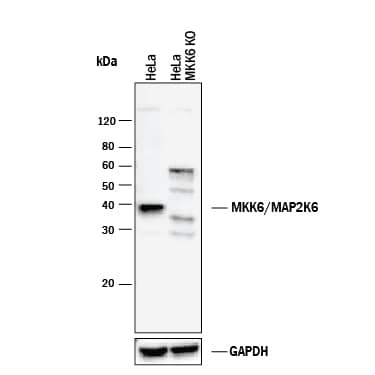Human/Mouse/Rat MKK6 Antibody
R&D Systems, part of Bio-Techne | Catalog # AF16041

Key Product Details
Validated by
Species Reactivity
Applications
Label
Antibody Source
Product Specifications
Immunogen
Ser2-Asp334
Accession # P52564
Specificity
Clonality
Host
Isotype
Scientific Data Images for Human/Mouse/Rat MKK6 Antibody
Detection of Human/Mouse/Rat MKK6 by Western Blot.
Western blot shows lysates of HepG2 human hepatocellular carcinoma cell line, C6 rat glioma cell line, and B16-F1 mouse melanoma cell line. PVDF membrane was probed with 0.1 µg/mL Goat Anti-Human/Mouse/Rat MKK6 Antigen Affinity-purified Polyclonal Antibody (Catalog # AF16041) followed by HRP-conjugated Anti-Goat IgG Secondary Antibody (Catalog # HAF109). For additional reference, recombinant human MKK6 (2 ng) was included. A specific band for MKK6 was detected at approximately 39 kDa (as indicated). This experiment was conducted under reducing conditions and using Immunoblot Buffer Group 1.Western Blot Shows Human MKK6 Specificity by Using Knockout Cell Line.
Western blot shows lysates of HeLa human cervical epithelial carcinoma parental cell line and MKK6 knockout HeLa cell line (KO). PVDF membrane was probed with 0.2 µg/mL of Goat Anti-Human/Mouse/Rat MKK6 Antigen Affinity-purified Polyclonal Antibody (Catalog # AF16041) followed by HRP-conjugated Anti-Goat IgG Secondary Antibody (Catalog # HAF017). A specific band was detected for MKK6 at approximately 39 kDa (as indicated) in the parental HeLa cell line, but is not detectable in knockout HeLa cell line. GAPDH (Catalog # AF5718) is shown as a loading control. This experiment was conducted under reducing conditions and using Immunoblot Buffer Group 1.Applications for Human/Mouse/Rat MKK6 Antibody
Knockout Validated
Western Blot
Sample: HepG2 human hepatocellular carcinoma cell line, C6 rat glioma cell line, and B16-F1 mouse melanoma cell line
Formulation, Preparation, and Storage
Purification
Reconstitution
Formulation
Shipping
Stability & Storage
- 12 months from date of receipt, -20 to -70 °C as supplied.
- 1 month, 2 to 8 °C under sterile conditions after reconstitution.
- 6 months, -20 to -70 °C under sterile conditions after reconstitution.
Background: MKK6
Mitogen-activated protein kinase kinase 6 (MKK6), also known as MEK6, and the closely related MKK3 are activated by pro-inflammatory cytokines and environmental stresses (1, 2). Both MKK3 and MKK6 are dual specificity protein kinases, phosphorylating and activating the p38 MAP kinases at Thr and Tyr positions within the phosphoacceptor sequence Thr-Gly-Tyr (3). Activation of MKK6 occurs through phosphorylation at Ser207 and Thr211 (4) by several upstream MAPK kinase kinases, including ASK1 and TAK1 (5, 6). Purification of E. coli-expressed wild-type active MKK6 capable of p38 alpha phosphorylation has been previously noted (7).
References
- Goedert, M. et al. (1997) EMBO J. 16:3563.
- Moriguchi, T. et al. (1996) J. Biol. Chem. 271:26981.
- Raingeaud, J. et al. (1995) J. Biol. Chem. 270:7420.
- Han, J. et al. (1996) J. Biol. Chem. 271:2886.
- Ichijo, H. et al. (1997) Science 275:90.
- Moriguchi, T. et al. (1996) J. Biol. Chem. 271:13675.
- Keesler, G. et al. (1998) Protein Expr. Purif. 14:221.
Long Name
Alternate Names
Gene Symbol
UniProt
Additional MKK6 Products
Product Documents for Human/Mouse/Rat MKK6 Antibody
Product Specific Notices for Human/Mouse/Rat MKK6 Antibody
The purchase of this product conveys to the buyer the limited, non-exclusive, non-transferable right (without the right to resell, repackage, or further sublicense) to use these reagents for research purposes only. No other license is granted to the buyer whether expressly, by implication, by estoppel or otherwise. In particular, the purchase of this product does not include nor carry any right or license to use, develop, or otherwise exploit this product commercially, which includes without limitation, provision of services to a third party, generation of commercial databases, clinical diagnostics or therapeutics, or drug development. This product is sold pursuant to a license from the University of Massachusetts, and the University of Massachusetts reserves all other rights to use these reagents. For information on purchasing a license for uses other than research, please contact the University of Massachusetts, Office of Technology Management, 333 South Street, Suite 400, Shrewsbury, Massachusetts, 01545.
For research use only

